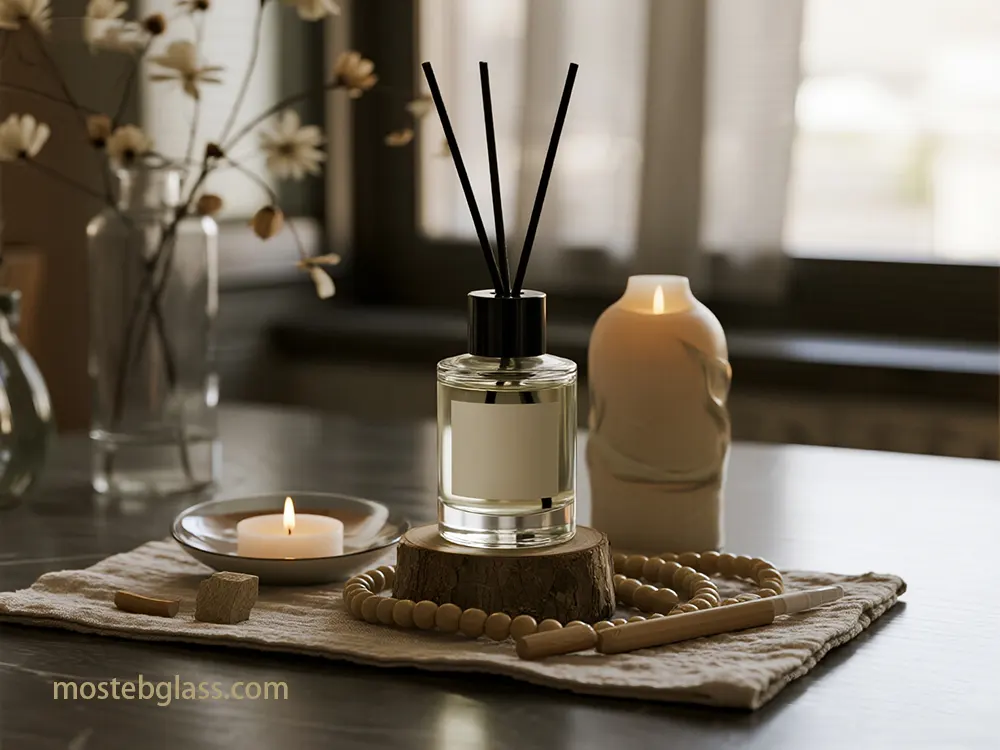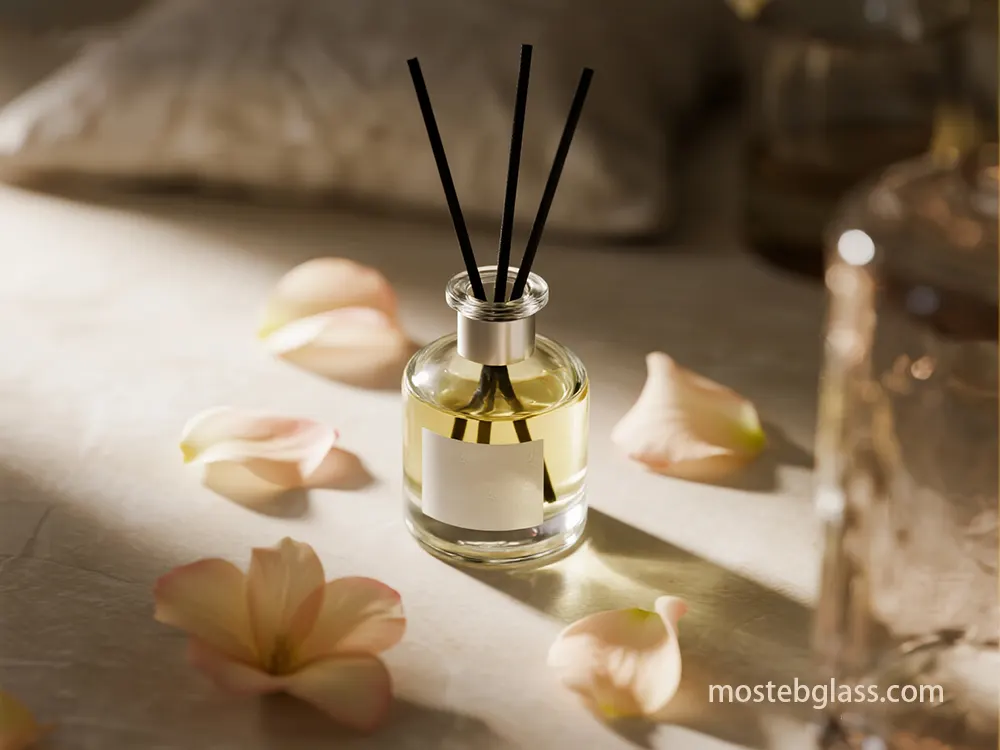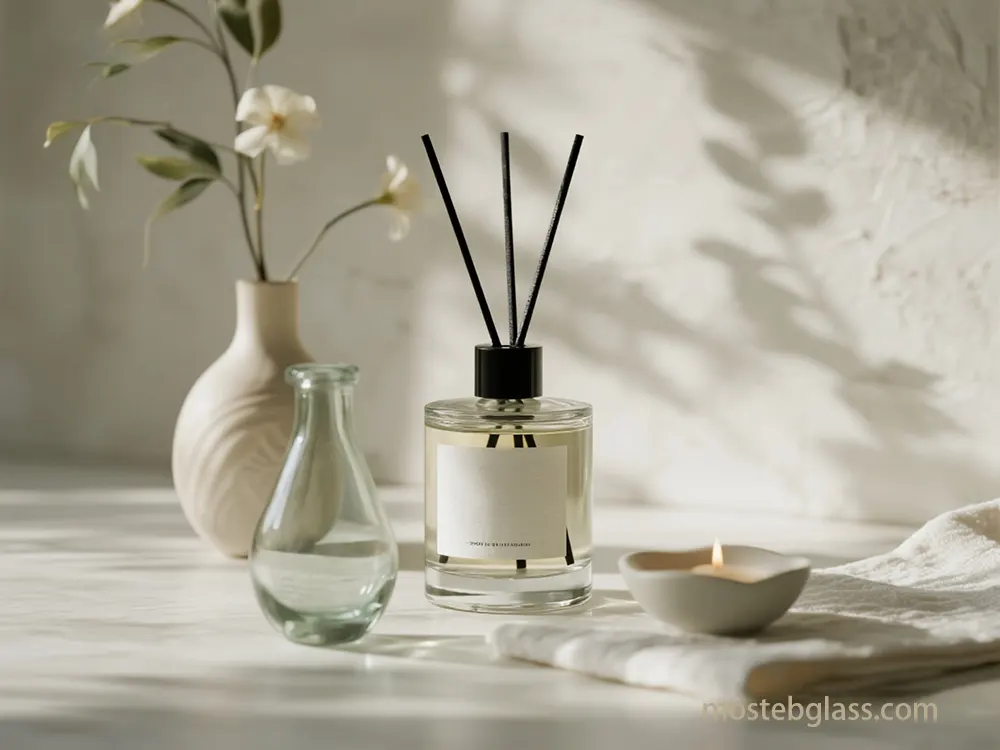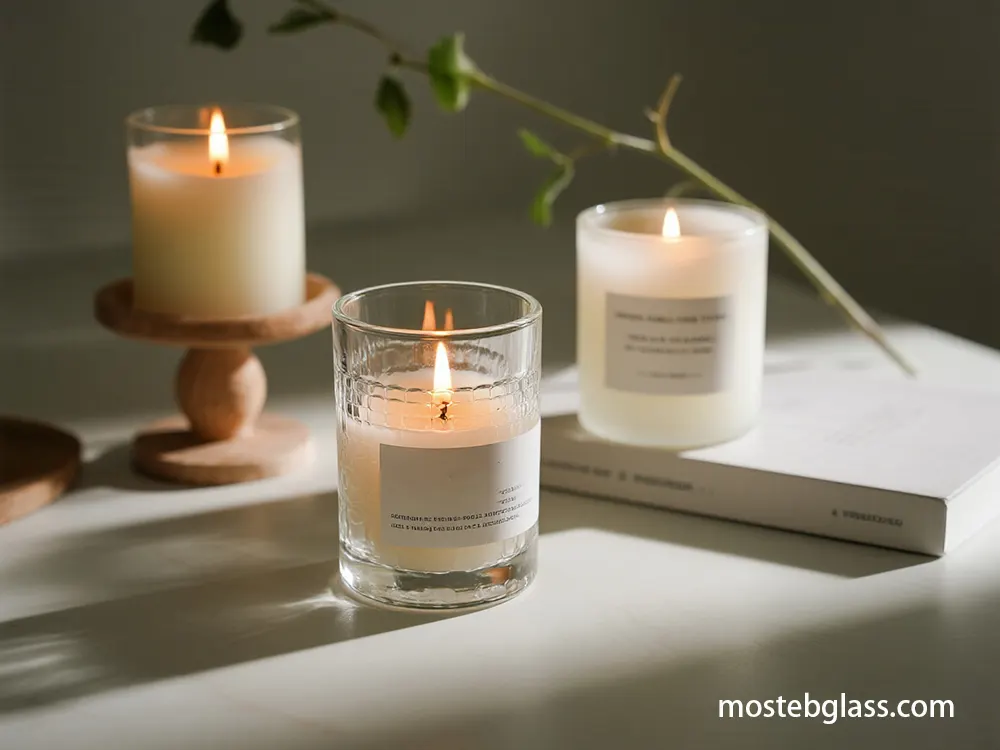1. 执行摘要
奢侈品群体:
对于挑剔的奢侈品市场,成本主张强调独特性、稀有性和每个精心再利用产品的独特故事。奢侈品制造商越来越多地使用电影般的叙事来传达可持续性。Mosteb应展示一个废弃罐子转变为精美高端产品的复杂旅程,突出工艺和环保管理。
大众市场:
对于更广泛的大众市场,重点可能在于价格合理、可及性和实际应用。该群体将通过强调实际的环境效益(减少废物、节省能源)和实际日常用途来触及,使可持续生活成为可能。
3. 产品组合 & 转型方法
玻璃的多样性,尤其是废旧蜡烛罐,允许多样化的产品组合,从简单的再利用到复杂的材料转型,以满足不同的市场群体。方法选择取决于期望的最终产品、运营规模和目标市场。
- 3.1. Product Categories from Used Candle Jars Our product portfolio will encompass a comprehensive range of items, designed for different market segments and leveraging various transformation methodologies:
- New Candles: The most direct circular application involves cleaning and refilling jars with new wax and wicks. This closed-loop solution can be incentivized through refill programs, encouraging repeat business and waste reduction.Mosteb could offer a premium refill service, providing discounts for returned jars, fostering loyalty and responsibility.
- Home Decor Items: Vases and Planters:
- Jars transform into decorative vases or mini planters for succulents, herbs, or small plants.Varied dimensions create diverse aesthetic appeal. Lighting Fixtures:

Upcycled jars become unique lamps, lanterns, chandeliers, or wall sconces, from simple DIY to professional designs.Integrating energy-efficient solar or LED lighting enhances eco-appeal.
- Storage Solutions: Jars are naturally suited for diverse storage: kitchen pantry (spices, dry goods), bathroom accessories (cotton balls, brushes), or craft supplies (buttons, beads).Personalized pincushions/sewing kits can be crafted by adding fabric tops .
- Decorative Accents: Jars can be artistically decorated using painting (frosted, stained glass), etching, or embellishments like lace, beads, jute rope, or fabric wraps.Seasonal/holiday decor offers a distinct niche.
- Craft Materials (Crushed Glass): Sand Art:
- Crushed, polished glass can be used for intricate layered sand art. Terrazzo/Concrete Aggregates:
- Crushed glass serves as a sustainable, visually appealing aggregate in concrete or terrazzo, offering eco-friendly alternatives and unique sparkling finishes for flooring, countertops, or architectural elements.Relevant for B2B construction/interior design partnerships. Art & Jewelry:
Finer crushed, polished glass can be used by artisans for mosaics, resin art, or unique components in handcrafted jewelry.
Glass Powder/Foam Glass:
Advanced processing transforms glass into fine powder or lightweight foam glass for specialized industrial applications like insulation, composite fillers, or advanced ceramics.
3.2. Transformation Methodologies
- Methodologies vary based on end-product and operational scale, ensuring efficiency and quality. Direct Upcycling/Repurposing:
- Minimal alteration, focusing on cleaning and minor enhancements.
- Cleaning and Preparation: Thorough cleaning removes wax, soot, and labels. Methods include freezing, hot water baths, or electric/stovetop griddles for wax removal.Labels are removed with hot water, soap, or specialized solvents.
- Minor Modifications: Adding new lids, functional pumps (for soap dispensers), or decorative elements enhances appeal and utility.
- Material Transformation (Crushing and Polishing): Breaking down jars into cullet or fine sand, then potentially polishing and coloring.
- Glass Crushing Equipment: Small-Scale Artisanal:
- Compact, user-friendly crushers (e.g., LSM Engineering G5, AaquaTools GLS 2.0) efficiently convert bottles into sand-like material.Budget options start around $890.
- Industrial Scale: Robust hammer or vertical crushers process larger volumes, producing fine cullet or sand with adjustable particle size (0.5mm-20mm).Brands like Compactors Inc. and Gradeall offer solutions with throughput from 50 kg/hr to 5,000 kg/hr.
- Glass-to-Sand Machines: Specialized machines (e.g., Expleco Limited, Krysteline Technologies) convert glass directly into high-quality sand or finer powder/foam glass.
- Glass Polishing Equipment: Artisanal Polishing:
- Mini glass polishing machines, pads, abrasive belts, and diamond wheels achieve desired finishes for small-scale projects.GT Tools offers kits for removing blemishes. Industrial Polishing:
Advanced flat glass edging machines (e.g., Neptun, Battellino) provide precision grinding and surface polishing for high-volume production.Robotic polishing ensures consistency and precision for large-scale operations.
Coloring & Treating Crushed Glass:
- Inks and Dyes: India ink or translucent spray paints provide vibrant, lasting hues.Alcohol inks can be used, but may fade.
- Surface Treatments: “Rub and Buff” adds metallic/colored finishes to edged glass.Decoupage mixed with liquid food coloring coats containers for artistic effects.
- 3.3. Operational Considerations Safety Protocols:
- Handling glass calls for strict PPE: reduce-resistant gloves, protection glasses, lengthy sleeves, long lasting pants, closed-toe shoes, and hard hats, especially in crushing areas.Ongoing schooling in secure dealing with, dust manage (ventilation, moist slicing), and chemical safety is important. Maintenance:
- Regular, proactive upkeep of all crushing and polishing device guarantees longevity, most effective performance, and consistent pleasant. This includes daily exams, ordinary cleansing, and monthly inspections of components.
- Strategically combining these methodologies, Mosteb can create a diverse, appealing, high-quality product line, maximizing value from every used candle jar. 4. Supply Chain & Operational Scalability
- Establishing a robust, reliable, and scalable supply chain for used candle jars is critical for long-term success, involving efficient collection, logistics management, and appropriate operational scale. 4.1. Anticipated Sources and Volume of Used Candle Jars
- We envision a multi-pronged sourcing approach, ensuring consistent, high-quality, and sustainable supply: Direct Consumer Collection Programs:
- Incentive-Based Returns:
- Implementing attractive programs (e.g., similar to Slow Made, Yankee Candle/TerraCycle partnership) where consumers receive shop credits, discounts, or free products for returning clean, unbroken jars.This engages customers, fosters loyalty, and promotes circular consumption. Convenient Drop-off Locations:
- Establishing accessible drop-off points at our retail locations, partner stores (e.g., zero-waste shops), or community centers. Placing containers where glass is frequently purchased (liquor/grocery stores) can maximize collection. Mail-Back Programs:
- For wider geographical reach, a free shipping mail-back program could be explored, especially for high-value jars.
- Cleaning Requirements: Clear instructions for cleaning jars (e.g., freezing to remove wax, washing with soap/hot water) will be provided to minimize contamination.
- Partnerships with Candle Manufacturers: Post-Consumer Jar Recovery:
- Regular, proactive upkeep of all crushing and polishing device guarantees longevity, most effective performance, and consistent pleasant. This includes daily exams, ordinary cleansing, and monthly inspections of components.
Collaborating with manufacturers to recover their post-consumer jars returned through their programs or from their waste streams. This aligns with Extended Producer Responsibility (EPR) standards.
Co-Branding Opportunities: Exploring at the same time useful co-branding projects in which Mosteb upcycles jars from a companion producer, growing precise product strains highlighting shared sustainability commitments.
Waste Stream Diversion: Engaging with producers who’ve inner waste streams of imperfect, mislabeled, or unsold jars for upcycling.
Waste Management Streams:
Material Recovery Facilities (MRFs):
Partnering with local MRFs to source glass, focusing on suitable candle jar streams. This requires negotiation and quality control due to contamination challenges in single-stream recycling.
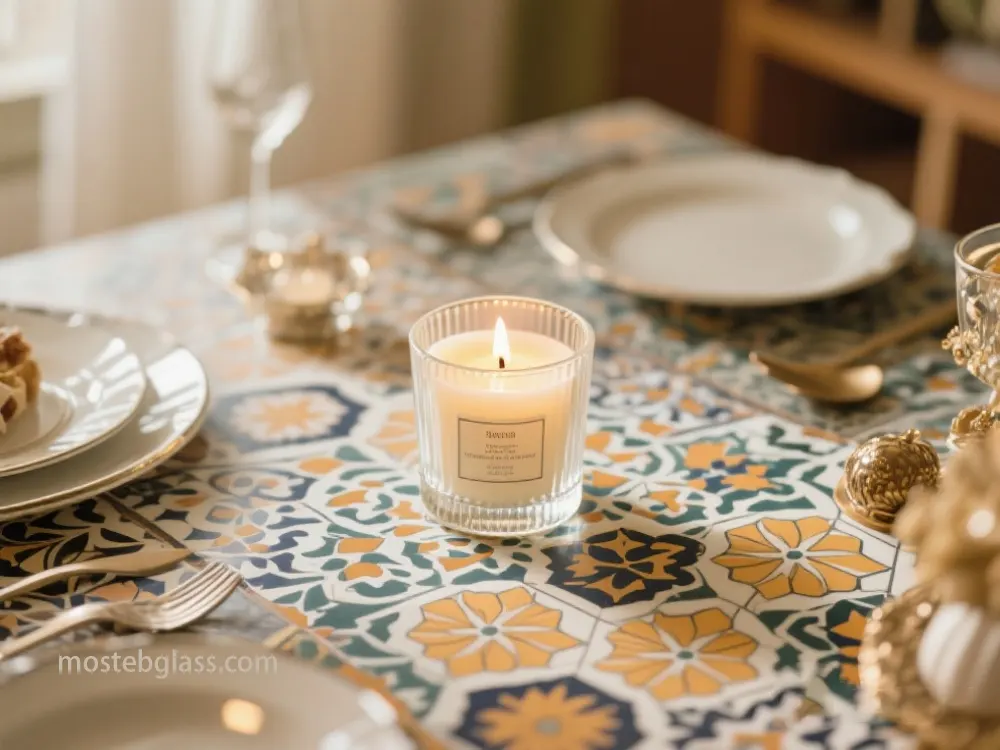
“Don’t Trash Glass” Programs:
Adapting successful initiatives like Diageo’s program for collecting glass from hospitality businesses could provide larger commercial volumes.
- Digital Waste Marketplaces:
- Utilizing platforms like Resourcify, Recykal, or LeeCycle to connect with waste generators, streamlining sourcing and potentially offering real-time trading for glass cullet.ASPIRE facilitates industrial symbiosis. 4.2. Operational Scalability
- Operational scalability will be a phased approach, moving from artisanal, small-batch production to industrial-scale operations as demand and supply grow. Small-Batch Artisanal (Initial Phase):
- Focus: High-value, unique home decor and new candles emphasizing bespoke craftsmanship, design, and storytelling.
- Collection: Primarily direct consumer returns and localized community partnerships.
- Processing:
- Investment in greater efficient semi-automated cleansing/sorting, and larger small-scale crushers for expanded volumes. Medium-Scale Expansion:
- Expanding product lines, introducing more standardized home goods, and developing B2B offerings. Significant expansion, formalizing partnerships with local businesses, smaller candle manufacturers, and regional drop-off networks.
- Investment in more efficient semi-automated cleaning/sorting, and larger small-scale crushers for increased volumes. Large-Scale Industrial Recycling (Long-Term Vision):
- Mass production of upcycled products, potentially including high-volume glass aggregates for construction, maximizing environmental impact.
- Formal, large-volume agreements with major candle manufacturers for post-consumer jar recovery and deep integration with municipal waste management. Significant capital investment for fully automated glass processing, including AI-powered sorting (up to 70 bottles/min, 99.8% accuracy),automatic glass breaking,and sophisticated polishing lines.Requires robust industrial dust control and safety protocols.
- Benefits: Achieving economies of scale, massive landfill waste reduction, and maximizing environmental/economic impact.
- 5. Financial Projections & Profitability Pathways Economic viability is based on meticulous analysis of price systems, various revenue streams, and strategic pricing. While upcycled products can be more costly to offer than the ones from virgin materials due to in depth cleaning, sorting, and first-class manage,their particular rate proposition, sustainability narrative, and growing client call for can pressure large profitability.
5.1. Cost Structures
Sourcing Costs:
- While raw material (used jars) is “free,” collection programs incur costs: financial incentives for consumer returns,logistical transportation from collection points, and potential fees for pre-sorted glass from MRFs or manufacturers. Sourcing from multiple, dispersed locations can increase transportation costs.
- Processing Costs: Labor-intensive process to remove wax, soot, and labels.Labor is a significant cost driver, especially for direct upcycling.
- Crushing and Polishing: Initial capital investment in equipment (e.g., small-scale crushers $5,000-$20,000, industrial pulverizers $20,000-$50,000).Ongoing operational costs include power (e.g., ≤1.5 kWh/ton),maintenance, and labor. Quality Control:
- Ensuring consistency in upcycled materials is challenging due to variations. This necessitates rigorous, customized quality control processes, adding to production costs. Manufacturing Costs:
- Labor:
- Processing Costs: Additional Materials:
- Crushing and Polishing: Initial capital investment in equipment (e.g., small-scale crushers $5,000-$20,000, industrial pulverizers $20,000-$50,000).Ongoing operational costs include power (e.g., ≤1.5 kWh/ton),maintenance, and labor. Overhead:
- Ensuring consistency in upcycled materials is challenging due to variations. This necessitates rigorous, customized quality control processes, adding to production costs. Marketing and Sales Costs:
- Expenses for brand development, digital marketing, market/trade event participation, and distribution logistics.
- Processing Costs: Direct Product Sales:
- Crushing and Polishing: Initial capital investment in equipment (e.g., small-scale crushers $5,000-$20,000, industrial pulverizers $20,000-$50,000).Ongoing operational costs include power (e.g., ≤1.5 kWh/ton),maintenance, and labor. B2B Sales:
- Ensuring consistency in upcycled materials is challenging due to variations. This necessitates rigorous, customized quality control processes, adding to production costs. White-Label/Custom Orders:
- Producing custom upcycled products for other manufacturers or clients searching for sustainable factors in their lines or advertising and marketing. Cullet/Glass Sand Sales:
Selling excess processed glass cullet or sand to different manufacturers (e.G., production aggregates, new glass production, abrasive blasting). While cullet prices are noticeably low ($10-$149/ton),this move offsets processing charges and contributes to a broader circular financial system.
Carbon Credits (Speculation):
Recycling glass notably reduces GHG emissions as compared to virgin glass production because of decrease electricity necessities.Companies could potentially earn carbon credits for verifiable emission reductions, supplying a unique destiny sales circulate.This calls for rigorous monitoring and 1/3-birthday celebration verification, potentially via structures like RecyclX.
- 5.3. Pricing Strategies & Profitability Pathways Profitability within the round economy for upcycled items is predicated on price-based totally pricing, aggressive positioning, and leveraging the sustainability narrative to command a top rate.
- Value-Based Pricing:
- Surface Treatments: Competitive Pricing:
While value-based, prices ought to stay aggressive within the broader upcycled/sustainable home items market. This might also contain strategically lower fees for mass-marketplace segments or highlighting accessibility. - Tiered Pricing: A tiered structure caters to diverse market segments: premium for unique handcrafted decor, mid-range for refilled candles, and accessible for basic functional storage.
- Surface Treatments: Competitive Pricing:
- Subscription Models/Leasing (Speculation):
- For refillable/reusable products, subscription or leasing programs could lower upfront costs for consumers while promoting extended use and waste reduction. Optimizing Cullet Composition:
- While 100% glass recycling is ideal, 25% cullet composition is often optimal for new glass production, balancing cost-effectiveness and environmental benefits.Selling excess cullet to other industries might be more profitable than 100% internal reuse if the external market is strong. Government Incentives and Grants:
- Securing grants, loans, and incentives for recycling, waste reduction, and circular economy initiatives significantly improves financial viability and accelerates growth.Programs like CalRecycle’s Recycled Glass Processing Incentive Grant Program offer substantial assistance. Circular Taxation Advocacy:
- Advocating for policy adjustments like decreased VAT on restore services, upcycled merchandise, or items extending product existence cycles ought to create a greater favorable monetary environment for circular businesses. Operational Efficiency via Automation:
While requiring better initial capital, strategic automation in cleaning, sorting, and crushing can drastically reduce long-time period labor costs, increase processing speed, and improve cullet exceptional.Crucial for massive-scale profitability.
- Strategic Partnerships: Collaborating with foremost candle producers for green jar recovery can notably reduce sourcing prices and create shared value.Partnerships with social firms can lead to price-effective hard work answers even as improving social impact.
- By handling costs, diversifying revenue, and adopting state-of-the-art pricing that highlights unique value and wonderful effect, Mosteb can establish a sustainable, worthwhile, and impactful challenge contributing meaningfully to the circular economy. 6. Environmental & Social Impact Assessment
- Transforming used candle jars aligns basically with round economy ideas, supplying great high-quality environmental and social impacts. Quantifying and transparently speaking these benefits is crucial for demonstrating fee to all stakeholders. 6.1. Environmental Impact Assessment
- A complete Life Cycle Assessment (LCA) will quantify environmental benefits of diverting used candle jars from landfills. Adhering to ISO 14040/44 standards, a “cradle-to-cradle” method will account for all product lifestyles cycle stages, emphasizing reuse and closed-loop recycling. Reduced Landfill Waste:
- Diverting hundreds of lots of non-biodegradable glass jars from landfills is a number one advantage, reducing land pollution and shielding assets. Energy Savings:

Recycling glass (cullet) consumes notably much less strength than generating new glass from virgin materials (sand, soda ash, limestone).Melting recycled glass calls for decrease furnace temperatures, saving 2-three% strength for each 10% cullet used,most important to decreased electricity consumption and GHG emissions
Reduced Raw Material Consumption:
- Using cullet at once reduces the want for extracting virgin raw substances. Every 1 kg of cullet replaces about 1.2 kg of virgin substances, retaining natural sources. Lower Carbon Emissions:
- Reduced strength intake immediately decreases CO2 emissions. CO2 emissions from virgin glass manufacturing (e.G., limestone decomposition) are prevented whilst the use of recycled glass. Water Usage Reduction:
- Incorporating cullet also measurably reduces water utilization. Key Impact Categories for LCA:
- Detailed LCA will check: Global Warming Potential (GWP) (kg CO2 equivalent),Energy Demand (primary and embodied strength),Air Emissions (SO2, CO2, NOx),and Eutrophication and Acidification. LCA Software and Data:
- Industry-wellknown gear like SimaPro, GaBi (Sphera), Ecochain Mobius, or openLCA might be used, gaining access to reliable databases (e.G., Ecoinvent) for correct analysis. Benchmarking:
- Comparative research will benchmark Mosteb’s upcycled merchandise towards similar virgin or other recycled fabric products, imparting clear proof of advanced environmental performance. Obtaining legit certifications like “Upcycled Certified”or “Global Recycled Standard (GRS)”affords 0.33-birthday celebration verification, enhances credibility, builds patron consider, and stops greenwashing.UPMADE® Certification could also be taken into consideration.
- 6.2. Social Impact Assessment Beyond environmental blessings, the initiative generates profound effective social affects. A Social Return on Investment (SROI) framework will systematically degree and account for those blessings, translating consequences into financial terms in which possible.
- Job Creation and Economic Empowerment: Upcycling creates diverse employment opportunities from series and sorting to crafting and advertising and marketing. This consists of direct jobs for nearby artisans, production workforce, and administrative roles, probably empowering marginalized groups.Recycling usually creates more jobs than landfilling, with reuse/upcycling creating even more.
- Skill Development and Knowledge Transfer: Structured workshops, training applications, and mentorship will foster talent-sharing and understanding switch, improving neighborhood craftsmanship, selling entrepreneurship, and building a professional circular economic system body of workers.
Community Engagement and Cohesion:
6. Environmental & Social Impact Assessment
Transforming used candle jars aligns basically with round economy ideas, supplying great high-quality environmental and social impacts. Quantifying and transparently speaking these benefits is crucial for demonstrating fee to all stakeholders.
6.1. Environmental Impact Assessment
A complete Life Cycle Assessment (LCA) will quantify environmental benefits of diverting used candle jars from landfills. Adhering to ISO 14040/44 standards, a “cradle-to-cradle” method will account for all product lifestyles cycle stages, emphasizing reuse and closed-loop recycling.
- Reduced Landfill Waste: Diverting hundreds of lots of non-biodegradable glass jars from landfills is a number one advantage, reducing land pollution and shielding assets.
- Cullet Supply Series and Quality: Recycling glass (cullet) consumes notably much less strength than generating new glass from virgin materials (sand, soda ash, limestone).Melting recycled glass calls for decrease furnace temperatures, saving 2-three% strength for each 10% cullet used,most important to decreased electricity consumption and GHG emissions
- Reduced Raw Material Consumption: Using cullet at once reduces the want for extracting virgin raw substances. Every 1 kg of cullet replaces about 1.2 kg of virgin substances, retaining natural sources.
- Lower Carbon Emissions: Reduced strength intake immediately decreases CO2 emissions. CO2 emissions from virgin glass manufacturing (e.G., limestone decomposition) are prevented whilst the use of recycled glass.
- Water Usage Reduction: Incorporating cullet also measurably reduces water utilization.
- Key Impact Categories for LCA: Detailed LCA will check: Global Warming Potential (GWP) (kg CO2 equivalent),Energy Demand (primary and embodied strength),Air Emissions (SO2, CO2, NOx),and Eutrophication and Acidification.
- LCA Software and Data: Industry-wellknown gear like SimaPro, GaBi (Sphera), Ecochain Mobius, or openLCA might be used, gaining access to reliable databases (e.G., Ecoinvent) for correct analysis.
- Benchmarking: Comparative research will benchmark Mosteb’s upcycled merchandise towards similar virgin or other recycled fabric products, imparting clear proof of advanced environmental performance.
- 认证: Obtaining legit certifications like “Upcycled Certified”or “Global Recycled Standard (GRS)”affords 0.33-birthday celebration verification, enhances credibility, builds patron consider, and stops greenwashing.UPMADE® Certification could also be taken into consideration.
6.2. Social Impact Assessment
Beyond environmental blessings, the initiative generates profound effective social affects. A Social Return on Investment (SROI) framework will systematically degree and account for those blessings, translating consequences into financial terms in which possible.
- Job Creation and Economic Empowerment: Upcycling creates diverse employment opportunities from series and sorting to crafting and advertising and marketing. This consists of direct jobs for nearby artisans, production workforce, and administrative roles, probably empowering marginalized groups.Recycling usually creates more jobs than landfilling, with reuse/upcycling creating even more.
- Skill Development and Knowledge Transfer: Structured workshops, training applications, and mentorship will foster talent-sharing and understanding switch, improving neighborhood craftsmanship, selling entrepreneurship, and building a professional circular economic system body of workers.
- Community Engagement and Cohesion: 可访问的网络系列套餐和活跃的居民参与工作坊/布局将促进共同事业和责任更接近废物减少。这促进了社会凝聚力,并围绕可持续性建立了集体认同。
- 教育机会: 该倡议作为一个动态的教学平台,提高人们对循环经济原则、可持续消费和废物成本的认识。教育推广,可能与社区学院/环保公司合作,赋予人们知识、可持续的选择。
- 支持地方经济: 优先考虑本地采购和活动开展同时有助于本地经济活力,使资金在社区内循环。
- 保护手工艺: 对于手工艺品,该倡议通过将这些技能融入先进升级再造来保护和推广传统手工艺。
- SROI衡量: 强大的SROI框架将系统地:确定范围(定义评估限制/目标);绘制成果(挑选积极变化,如创造的工作岗位、转移的废物、工作坊成员);展示并评估成果(在可能的情况下分配经济价值,例如降低医疗保健成本的经済价值、扩大手工艺利润、教育成就成本);确定影响(通过考虑沉没成本、归因、替代、脱落来确定净影响);计算SROI比率(将总社会/环境影响成本除以经济资金成本;比率>1显示良好回报);报告发现(向利益相关者透明地传达SROI结果,提高信任、吸引资金、促进合作)。
通过仔细评估、量化并透明地传达其环境和社會影响,Mosteb将展示其对可持续发展的承诺,并为其作为负责任、现代和有影响力的公司的价值建立有说服力的案例。




